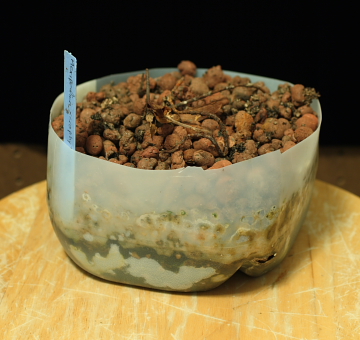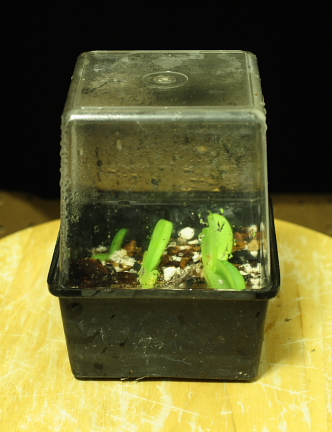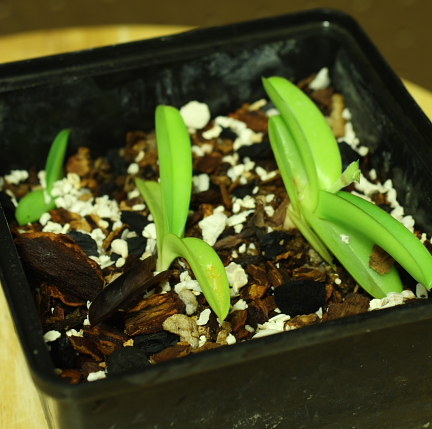Hello all,
After reading some posts here about how people grow their mexipediums, I decided what I was trying wasn't going to work and changed things a bit.
I had it in semi-hydro pellets in old milk container bottom under bright fluorescent light

old container with remnant dead plant material
After I had the plant in it a while it looked like a spike was forming but then it blasted. A few times I tried to feed it but growths/leaves would burn. I read about Heather's paph mix and saw her pictures of her plant in that mix and thought to try it. I also saw post with picture of a plant that had been in high humidity and the growths had emerged right from the side of the previous crown instead of at the end of long runners; decided I needed to get my humidity higher and misting didn't seem to work. Plant was just sitting there looking unhappy.

Plant in new media, in high-drain plastic pot with high dome cover
Plant is in south kitchen windowsill, and pot sits on top of cube of oasis. I keep the plant covered most of the time, and only mist the media about once every two weeks. I noticed a little while back that a tiny growth was emerging from the top of one of the crowns, and now looks like a flower spike.

The leaves look happier, and I'm hoping that new growths will come out right next to the plant because of the higher humidity, and of course I'm hoping that the spike continues and I get to see/show you a flower picture in a few weeks! I will be extremely careful in avoiding getting water on the bud as well, and won't be fertilizing it anytime soon though if it flowers I might give it some seaweed extract after it is done. Heather's paph mix is small fir bark, small charcoal, small sponge rock and just a little chopped sphagnum. I used the chopped sphagnum (supersphag) that is produced for disa culture. Since my disas are no more at the moment, at least a little of it is going to good use! I also include a small amount of crushed coral as I read that mexipedium is one of the slippers that 'should' be appreciative of added calcium.
After reading some posts here about how people grow their mexipediums, I decided what I was trying wasn't going to work and changed things a bit.
I had it in semi-hydro pellets in old milk container bottom under bright fluorescent light

old container with remnant dead plant material
After I had the plant in it a while it looked like a spike was forming but then it blasted. A few times I tried to feed it but growths/leaves would burn. I read about Heather's paph mix and saw her pictures of her plant in that mix and thought to try it. I also saw post with picture of a plant that had been in high humidity and the growths had emerged right from the side of the previous crown instead of at the end of long runners; decided I needed to get my humidity higher and misting didn't seem to work. Plant was just sitting there looking unhappy.

Plant in new media, in high-drain plastic pot with high dome cover
Plant is in south kitchen windowsill, and pot sits on top of cube of oasis. I keep the plant covered most of the time, and only mist the media about once every two weeks. I noticed a little while back that a tiny growth was emerging from the top of one of the crowns, and now looks like a flower spike.

The leaves look happier, and I'm hoping that new growths will come out right next to the plant because of the higher humidity, and of course I'm hoping that the spike continues and I get to see/show you a flower picture in a few weeks! I will be extremely careful in avoiding getting water on the bud as well, and won't be fertilizing it anytime soon though if it flowers I might give it some seaweed extract after it is done. Heather's paph mix is small fir bark, small charcoal, small sponge rock and just a little chopped sphagnum. I used the chopped sphagnum (supersphag) that is produced for disa culture. Since my disas are no more at the moment, at least a little of it is going to good use! I also include a small amount of crushed coral as I read that mexipedium is one of the slippers that 'should' be appreciative of added calcium.



